- Note: So this post is full of approximately one million photos. As I was going through them, it was so easy to just be overwhelmed and for them to all look the same. But… I really enjoy taking the time to pause and look at at least a few of them really closely. I was there, in that spot, looking out at this wholly unimaginable landscape before me. It looks like a cartoonish green screen. The colors and images look enhanced. But this is how it was. Greens and blues and mountains and valleys and ruins. I have to take the time myself to pause and truly appreciate these moments, and I hope you enjoy them too. But I know there’s a lot. Like, really a lot of pictures. 🙂
Today is another early morning, as my driver will be here to pick me up at 5:50 a.m., a time that does technically exist on most clocks, but has rarely been observed. I get up at 4:30 to pack and get dressed and realize I have, in my exhaustion, not packed very well. You see, the train to Machu Picchu has a rather strict baggage limit, so general practice is to pack an overnight bag for the 1 or 2 nights at Machu Picchu, and leave the rollerbag suitcase at the Cusco hotel. This is fine, but…. in my exhaustion, I didn’t pack the proper things that I needed for this part of the trip. So I wake up to get dressed and discover that my sports bra is in Cusco. I have with me only the sweaty bra I wore yesterday for hiking ruins, and I have 2 more days ahead of me. I turn it inside out and soldier on. I also realize I’ve left my hiking shorts, the ones I bought specifically for this trip, in Cusco. So now, I’m stuck with a dress and a pair of pants. So I’m like the only person trudging up and down Machu Picchu in a dress today. In hindsight, I think I would recommend packing from home for this specific part of the trip. Like, already have the overnight bag packed how you want it, and keep everything else in the roller bag. I severely underestimated the level of exhaustion I would experience on this trip, both from the very early mornings as well as my general inability to sleep well at altitude. So… on with the day.
The Vistadome
My driver arrives at 5:50 a.m., and we drive 45 minutes or so to get to the train station back in Ollantaytambo (I promise this is a super fun word to say, just sound it out in Spanish). My train leaves at 7:05 a.m., and they request that you arrive 30 minutes before departure. So I’m right on time. I arrive just as the earlier train is leaving the station, and sit in the waiting room for a few minutes while my train pulls in and stops. The station has a nice cafe with boxed lunches and breakfasts.

The PeruRail VistaDome 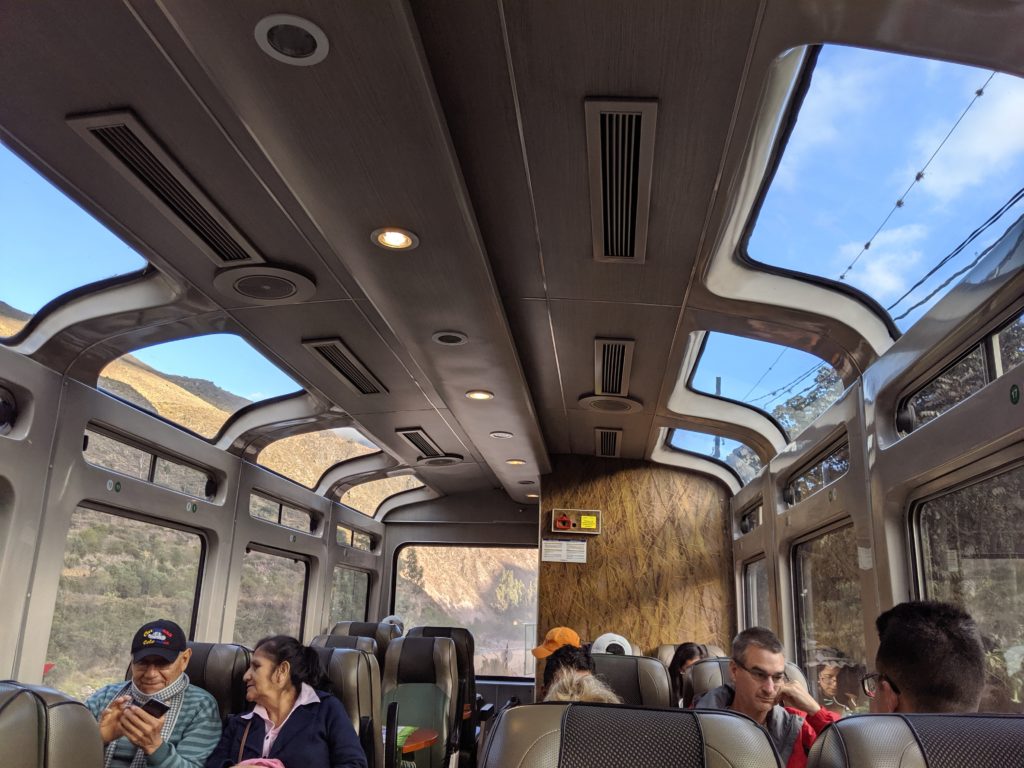
Glass top – and glass front train
We board the train and I am in the A car, which is the first one. Yay! (Good job tour company) This train is called the Vistadome, and with good reason: the sides and much of the roof of the train car are glass windows. You can look out at the mountains and glaciers and the Urubamba river. And the engine is in the middle or back of the train (I didn’t go looking for it), so the A car is like a glass cube floating head-first through the mountains. You can see directly out the nose of the train. I am seated in a 4-person table, and there are 2 people across from me, but their guide comes to get them and move them to another car before we leave. So it’s just me. I have plenty of space, and amazing views. Across the aisle there are 4 Americans, and their guide is sitting at a different table. He is continually getting up, coming over to their table, and pointing at things and explaining it to them. Fortunately, I somehow managed to bring my noise canceling headphones (though not my hiking shorts or a bra), so I put those on, tune them out, and just sit with my own thoughts as I watch the world go by.

Coca tea and a choco brownie
They serve coca tea and a chocolate brownie as a little breakfast on the train. Ollantaytambo is the halfway point for this train (from Cusco to Machu Picchu), so it’s only a 2.5 hour ride. The entire time, the train feels like we’re going down hill, and the tracks follow the river through the valley. We go through tunnels carved through the stone mountains, narrow tunnels that barely accommodate the size of the train. Most of the way, there is only one track, so there is no easy way to manage 2-way traffic. The train does stop several times in little double-track spots to let other trains going the opposite direction pass. We make one stop, about half an hour from the end of the journey, to let out all of the passengers who are hiking the Inca Trail from here to Machu Picchu. This is where the scale of hiking vs train really sinks in. It’s 30-60 more minutes by train…. 3-4 days of hiking. I’m instantly glad that I didn’t take that option, as I have thoroughly enjoyed the amount of ground I’ve been able to cover and the different things I’ve seen.
Aguas Calientes – Machu Picchu Pueblo
I arrive in the town at the base of Machu Picchu, which was once called Aguas Calientes, but has officially been renamed Machu Picchu Pueblo, though most everyone uses both terms interchangeably. This is a tiny town that straddles the Urubamba River. The first thing I notice as I get off the train is the smell. I’m not sure if it’s the altitude or just that I haven’t been outside the city in a while, but wow. The smell of the water and streams and plants. This is more of a rain forest-y area, instead of the more dessert area of Cusco. So everything smells wet and kind of tropical and earthy. It’s amazing, like instantly relaxing.

Welcome to Machu Picchu 
The sign says ‘Machu Picchu Pueblo’ but I can’t get it all…
There are no roads, only the one that buses take up and down to the Machu Picchu ruins. So everyone gets around on foot. Porters have wheeled carts, pushing everything from tourists’ luggage to stacks of 5-gallon water bottles or cases of beer, up and down the hills and over the arched bridges. It is hard work, and it’s amazing to see how the city runs. My hotel is only a 10 minute walk from the train station, and there’s a big open air market to navigate in between. It’s the same stuff that’s for sale in Cusco, but everything says Machu Picchu on it.
I arrive at the hotel at about 8:45 a.m. and drop off my bags, though it’s far to early to check in to my room. I sit in the lobby to wait for my passport and documents to be scanned and returned, and a waiter from the restaurant brings me a welcome snack. Very fancy. I have a chicha morada in a champagne flute and a sweet potato twirl with yellow pepper sauce and a chia seed sauce. It is very pretty and quite tasty.
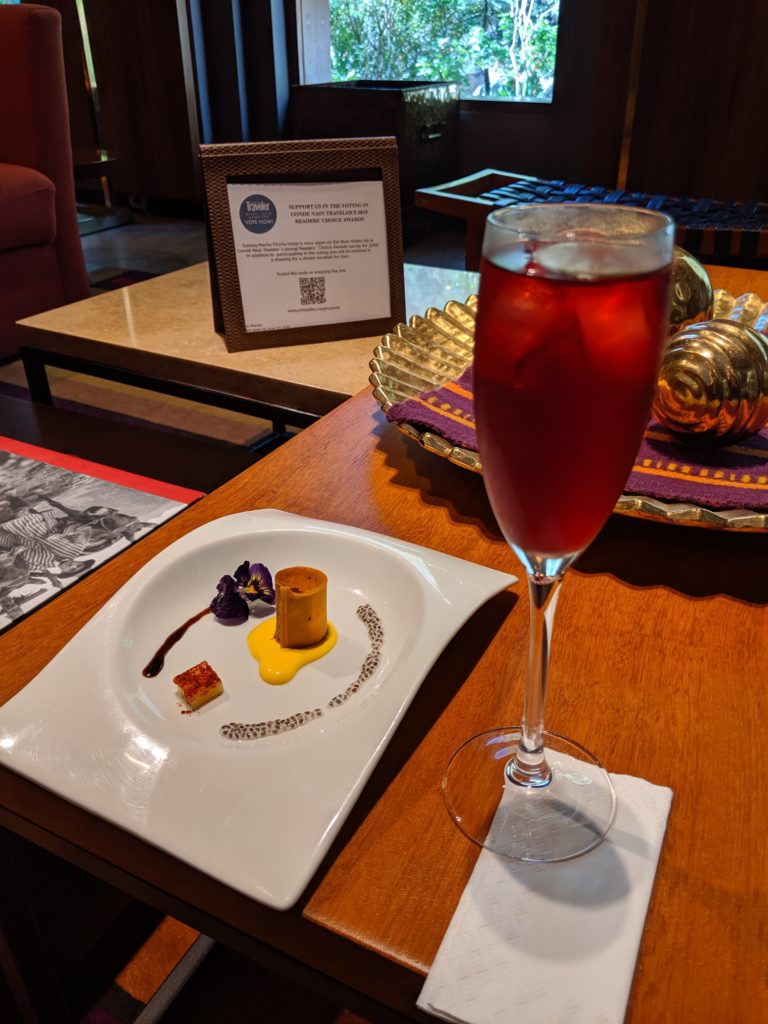
Just your average ‘Welcome to our hotel’ snack 😀 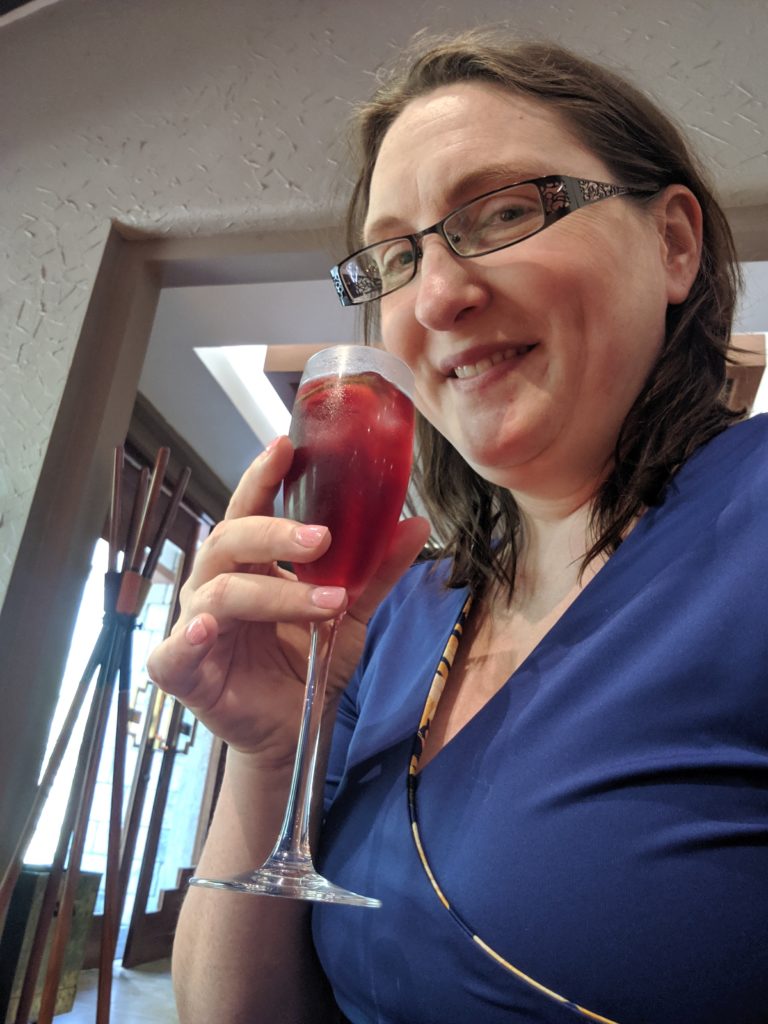
Delicious and refreshing
The Journey to the Top
(At this point, there will be a gratuitous number of photos from Machu Picchu.) At 9:15, my guide Wilfredo arrives. We walk the 10 minutes back to the bus station and catch the next bus up the hill mountain. The bus ride takes about 20 minutes, but it’s switchbacks all the way up. And it’s really a one-lane road, but buses are going up and down, so there’s a good amount of negotiating as the drivers pass each other. We stop several times, back up into a little turnout, and let the oncoming bus go by. I think the downhill buses have the right of way. As we go through switchback after switchback, there are signs for the hiking path, because you can climb the mountain on foot if you’d rather. I can see from the bus that the hiking path is just stairs. It’s just straight up.
We arrive at the top and our tickets are for the 10 a.m. entry time. So we have 10 minutes to spare. And they will absolutely not let us in 10 minutes early. So I stop at the little cafe and grab an empanada to take with me. It’s better than a cliff bar. Finally, at 9:58, Wilfredo says we can go in, and the ticket guy lets him in with his tour guide badge. Then he actually spends the full 2 minutes just slowly examining my ticket and passport until it is precisely 10 a.m. Cool.
From there, we enter Machu Picchu. The entrance is on a flat spot, to allow buses and drop-offs, but once you get in, it’s all stairs all the time. We begin our ascent from the ‘ground level’ of the Machu Picchu ruins. We can see the ruins, but we’re on a completely different ridge. We are on a terraced farming area, so lots of stone walls and terraces, but we have to climb up and up the terraces to then reach the Inca trail that goes down into the entrance of Machu Picchu. From the outset, it is obvious that this is a very defensible position. No one is sneaking up on Machu Picchu.
So we begin climbing and, again, we are several hundred (maybe a couple thousand) feet of elevation above the town I slept in last night. So the air feels thin and cold, and completely unsatisfying as I am hiking up the stairs. Wilfredo is just walking and talking and I am just trying to keep up. He occasionally stops in a corner, but this first bit of hiking to get to the ‘guard house’ and the top of the terraces, is by far the most strenuous part of the day. Along the way, Wilfredo is telling me all sorts of interesting things. He talks about the history of Machu Picchu. When it was built, which Inca king likely ordered it, what we think it was used for. No one actually knows why it was built or who lived there or what they did. Wilfredo’s best guess is that it was an educational place, like a university. But there is archaeological evidence for several different conflicting things. He actually tells me about the history of the ‘discovery’ of the place, the various archaeologists who have visited over time, and the positive and negative effects that the tourism has had on the local communities.
The story is that Hiram Bingham was following the Inca Trail, looking for the ‘Last City of the Incas’. But along the way, he found a village of farmers in the mountains nearby. He asked them about Incan ruins, and one family sent their small child to show Hiram Bingham where he goes to play. The locals all knew of the place, but just let it be. They neither destroyed it nor tried to preserve it. So then Hiram Bingham writes a while book about what he calls the “Lost City of the Incas”, and so begins decades of visits from curious archaeologists and adventurous tourists. Eventually it is named a UNESCO world heritage site, which brings it more fame and more tourists, but puts a lot of restrictions around the site and how it must be preserved. No reconstruction is allowed; when a rock wall falls over, it’s just a pile of rocks now. Maintenance is allowed, to prevent the rock walls from eroding and falling over. But everything must be original, no reconstruction. Over time, the farmers in that village left. It was a difficult life, and they moved elsewhere. But new tourism industries created the populated town of Aguas Calientes (now called Machu Picchu Pueblo). And now… the government of Peru is going to build an airport right next to Machu Picchu so you don’t have to fly to Cusco and take a 4 hour train. There is much debate about how terrible of an idea this is.
-Synopsis of Wilfredo’s history of Machu Picchu
Wilfredo is great, blending stories of the history of the Incas with stories of the archaeology of the place and stories of being a tour guide and what it’s like now. Sometimes he points at things and shows me where areas that were once accessible are now roped off, due always to some tourist shenanigans. One tower is roped off because, once you go inside, no one can see you…. so people were doing ‘whatever they want’, which clearly includes some amount of graffiti/carving ones name into the rocks. People are assholes. But, on the bright side, it does appear that the government or whomever is in charge here takes their job of preserving this site very seriously. As we climb terrace after terrace, there are clearly marked spots where you’re allowed to walk and places where you aren’t allowed to be. There are signs with cameras on them, to let you know the best photo spots, always little cul-de-sacs for photos, to keep people from crowding and blocking the walkways. And there are real, human workers there. They are quick with their whistles any time anyone does anything against the rules. And that’s constant. Everyone wants the best selfie. So they try to get away with going into roped off areas, climbing the stone walls, and any sneaking in with professional photography equipment. All of these things will get you a sharp whistling, and have your camera confiscated and your photos deleted. I appreciate that those workers are here, am very sad that they have to be here, and honestly, I think anyone who gets the whistle should be thrown out and their passport noted and not ever allowed back in. No tolerance for that shit, the rules are clearly posted and notoriously well-enforced.
Anyway, we get to the top of the terraces and there’s a big flat spot with some llamas! Wilfredo explains that the climate here is too harsh for alpacas, so everything here is llamas. Alpacas get too hot with all that wool. But, he also says they aren’t really wild llamas anymore. They used to just be roaming llamas, but tourists would pick grass and feed them to get the llamas to pose for photos. And the llamas got fat. So now, they rotate in a few sets of llamas, to keep them from getting too fat, but to still have some semi-wild llamas wandering Machu Picchu. The llamas are allowed to go wherever they want, and they wander through the roped off areas as well as hanging out right next to the tourists in the areas we are allowed to be in. They’re cute and seemingly oblivious to the people. I even watch a few times as the llamas fearlessly jump from one terrace down to the next one. They’re like a mountain goat mated with a poodle. So freaking cute, but also weirdly agile for how stiff they look.
Wilfredo is also great about offering to take photos and taking my purse and my hat so I have great pictures. He seems ok with this being part of his job. And he’s good at both finding spots that have a good vantage point to look down into the ruins, and finding spots where there aren’t a hundred other people trying to take a photo. He also tells me the story of some guy who tried to take a jumping photo, lost his balance, and fell down several of the terraces. He nonchalantly tells me about how it was 8 a.m. the next day before his body was found, and when they found him, every single bone in his body was broken. So you get a sharp whistling if you even think of doing a jump photo. From the top of the terraces, you can see that famous post-card type view down into the ruins, and it’s just breathtaking and beautiful. The mountains and wilderness around, and the immaculately groomed ruins, it’s all quite breathtaking.
Wilfredo shows me a couple of nice hiking paths to take tomorrow, when I return to the site alone, and we begin our hike down all of the stairs into the actual ruins. Here, he shows me which rooms were used to store food and grain and how they kept things cool. He shows me which ones were used for housing, and the difference between the houses and the temples. It is clear that there are different classes of people living here, as the quality of the stonework on the buildings varies considerably. We look at the temples and even rooms that we aren’t sure what they were used for. We talk about how this particular site has withstood several major earthquakes. And we look at some stone walls where the stones now have a few inches of space between them, caused by the earthquakes. And if you look at the crack between the stones, you can see that they aren’t flat. Part of how these walls withstand so much time and weather and geological events is that they aren’t just square blocks stacked together. The joints between blocks have twists and curves to them. Some are actually carved, like lego blocks, with interlocking parts. All made with no iron tools, only stone. No one knows how they managed to carve and move such huge stones.
After we finish our tour, we are back at the entrance. We stop at the little station and get a Machu Picchu passport stamp (I have no idea how legal this is to stamp a non-border crossing stamp into your passport.) I say goodbye to Wilfredo and have lunch at the restaurant at the top of the hill. I had researched it and read that this is a really good restaurant, the fanciest available, and it’s a must-visit. I will let you know that this is not the case. It was loud and crowded. Service was terrible. Food was passable, but nothing particularly good. I was very disappointed with this, but I had specifically requested it, so… my bad. If I was starving and didn’t think I could handle the half an hour to take the bus back down the hill, I can see how this is an ok option, but the empanada from the little cafe was way better. I’d just stop there. But ç’est la vie.
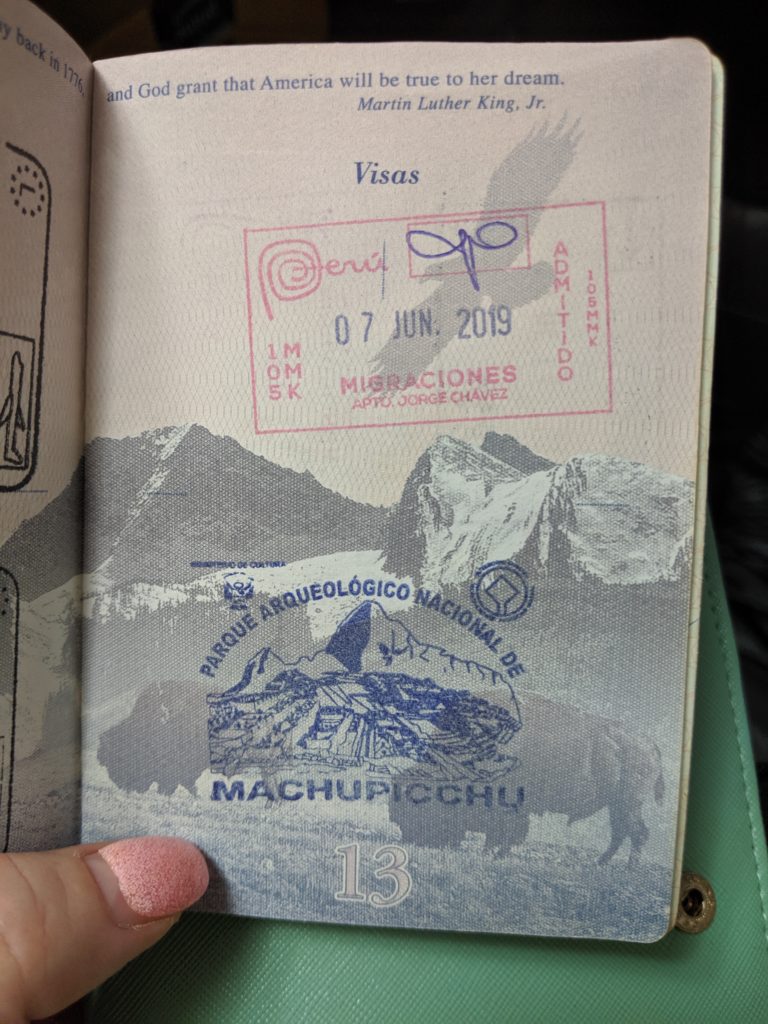
Peru entry and Machu Picchu stamps 
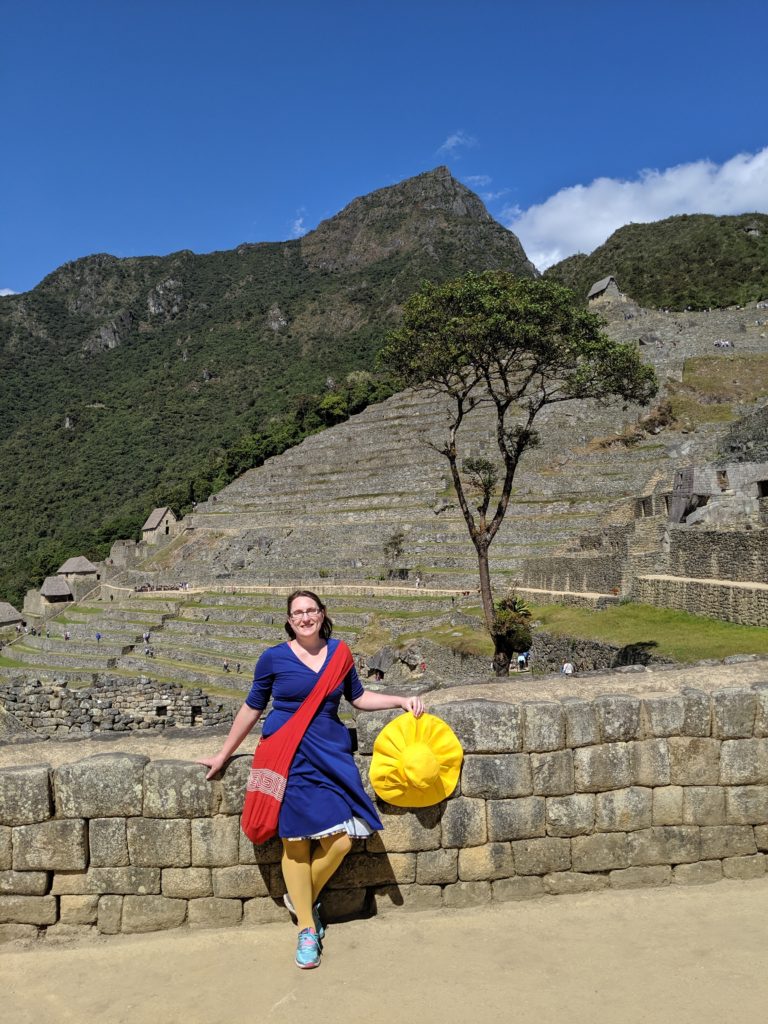
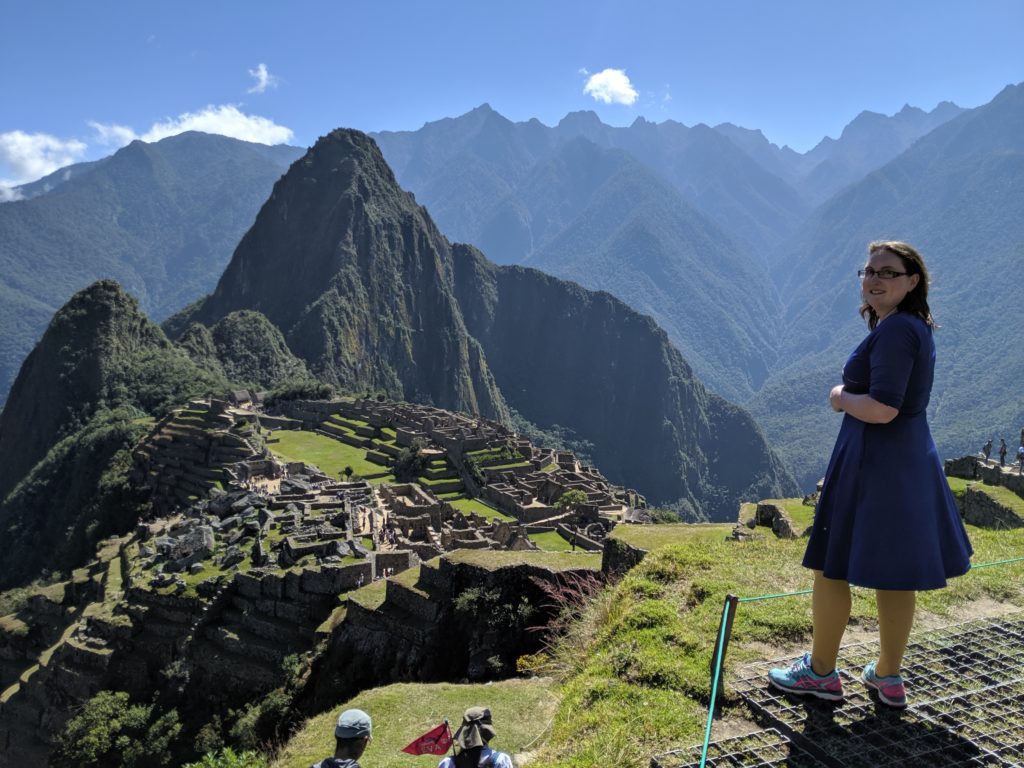
I find a spot at the restaurant and after a very early morning of just one overwhelming experience after another, I sit and collect myself and have a quick little cry about it. I’ve talked for over a decade about going to Machu Picchu…but some part of me had always thought I would never actually go. Like, it’s a huge physical commitment, and I’m not getting any younger. And there have been so many other places I wanted to go and got to see. There’s no reason I deserve to get to do literally everything I can imagine wanting to do. And yet now here I am! But I didn’t spend weeks or months planning it. I didn’t sit around and imagine what I would do with every second of every day, and know how I would feel and what I wanted to see. I kind of just jumped right into it. So the overwhelming feeling of where I am and how I got here kind of washes over me all at once. And I’m sitting at a window seat, literally looking out at the ruins. It was a whole moment that I had with myself there.
Down into Town Again
After that, I get in the line to take the bus back down. It’s a good half an hour wait to get onto a bus, but they’re organized and the line moves very quickly. In fact, everything on this trip has been so completely organized and on time and runs like a well-oiled machine. I’ve been plenty of places in the world and I can’t say I’ve been anywhere that felt this well-managed. So I go back down and spend an afternoon shopping in the market and walking through town.
Aguas Calientes feels like a beach town. There is no beach in sight, but the city is built only for tourism. Theres are dozens and dozens of restaurants, all with picture menus displayed outside and guys with menus trying to entice tourists inside. And there are massage parlors, with ladies walking around with spa menus, offering everything from 30 minute foot massages for weary travelers to full half-day spa treatments with body wraps and hot tubs and massages. You have to walk a little farther to the edge of town to see where the locals live, to find the elementary school and the children outside practicing soccer drills, because of course they are. The artisan market is very similar to the shops in Cusco, but it’s all outdoor stalls, booth after booth of the same mass-produced stuff, with mostly ladies calling out. “Señorita, beautiful bags. T-shirts, señorita? What you looking for?” Throughout my trip, my ghastly pallor has certainly marked me for attention from every shop keeper. I was called ‘Señorita Blanca’ plenty of times, which amuses me greatly because my passport is still in my maiden name, White. So I am literally Ms. White, Señorita Blanca. I pick up a few Machu Picchu t-shirts with llamas on them, and a few cute things for Pooka before I make my way back to my hotel.
Hotel – Spa time
I had planned ahead and I assumed that I’d be exhausted by this part of the trip. So I had made myself a spa reservation at the hotel. So I go back to my room and shower since I’ve been hiking and sweaty all day. Then I show up to the hotel spa in my pajamas (because I didn’t pack any extra clothes in my overnight bag and I’m definitely not putting that sweaty sports bra back on after a shower). The spa, like everything on this trip, is amazing. My spa tech shows me back to the dressing rooms and hands me a giant gift basket with my spa robe, some towels, silly paper disposable underwear, and slippers. I change and put all of my things into a locker. Wearing my comfy robe and slippers, I make my way to the treatment room.


So relaxed
I have signed up for a Coca Leaf Body Wrap and an hour massage. I thought it sounded like a fun and unique spa treatment. But what I didn’t know was that the coca leaf is mixed with mint leaves, to open the pores and get the natural oils to soak into your skin. So she begins the treatment with a salt body scrub, using salt from the nearby salt mines. Then she rinses off all of the salt from my newly exfoliated skin, and begins, one limb at a time, applying this coca-mint mixture. So like, this was the most intense spa treatment I have ever had. The bed is warmed and the room is warm, but as soon as she started putting the paste on my legs, it was freezing. It’s like bathing in Icy Hot. By the time she finished my legs, arms, and back, my body is involuntarily shivering intensely. She says nothing, so I assume this is totally normal. I went into that mental space where you just accept it and try to calm your body. Once the paste was applied, I heard this strange noise…. she has a weighted kind of rubbery blanket that she puts over me and wraps me up tight like a cocoon. The blanket has been sitting on the radiator so it’s very warm and cozy. Then she says she will leave the room for 15 minutes so the paste can soak in.
What began with me wondering if I had the ability to sit there in this frigid wrap and endure 15 minutes ended with me waking myself up snoring before the 15 minutes was up. The freezing mint had mellowed out, and I haven’t slept in a week. She returns and unwraps the blankets, rinses off all of the paste, and then pulls off that layer of blankets and a sheet of plastic, and boom, I’m in a fresh set of warm blankets. Now she starts the hour long massage and it was pleasant and a pretty light, gentle massage.
After the massage, she leads me back to the dressing room, which is now stocked with shower supplies, and I take a shower, washing off all the massage oils and washing them out of my hair. Then I go back to my room and get dressed for dinner.
Dinner
The hotel includes dinner with the room, and while I was a bit wary of this at first, it turned out to be an absolutely lovely dinner. The hotel restaurant is very fancy, and the dinner options were both beautiful and delicious.
They bring me a basket of assorted breads first, with a yellow pepper butter that is quite delicious. Then there is the amuse bouche course, which consists of little agar jelly balls made from local river algae. They are strange little gelatinous balls mixed with local fruits and cheeses and a nice sauce, and served with some potato crisps. It’s good, weird, interesting.

Bread basket and ‘algae caviar’ *and a pisco sour 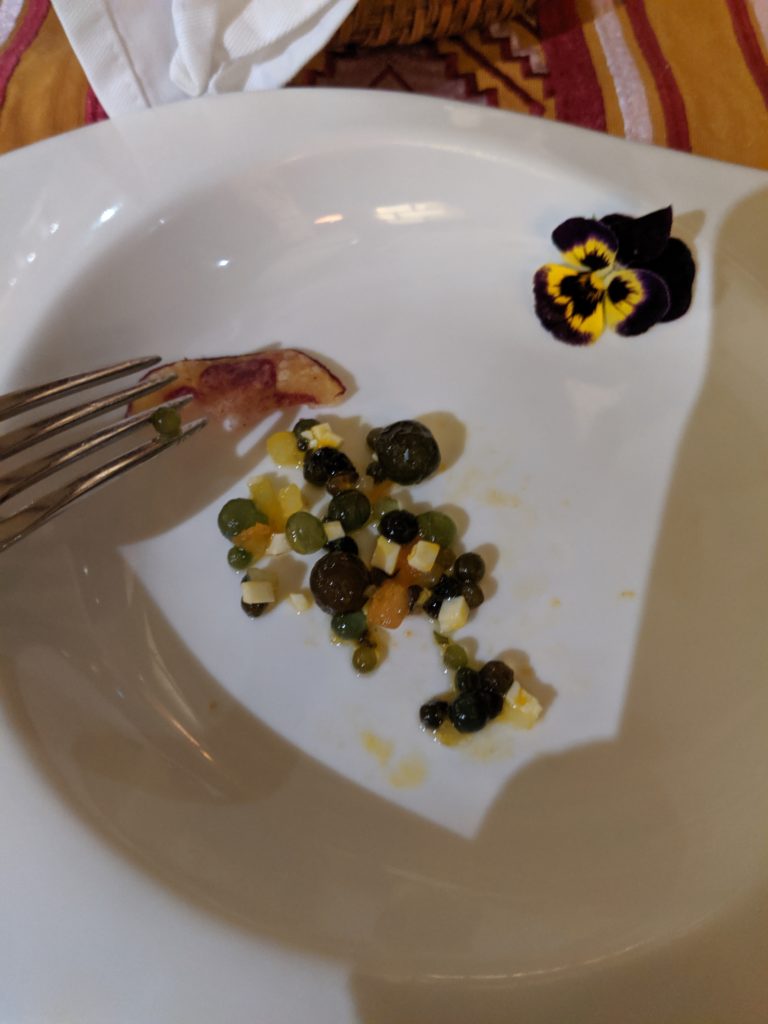
Chopped fruit, cheese, and agar drops of river algae
For my first course, I ordered the causa, which has been one of my favorite foods this trip. Instead of layering the potatoes and veggies and avocados vertically, they make it interesting by essentially making a sushi roll of potatoes with avocados in the middle, then topping it with bits of fried chicken and chicken salad and garnishing with fried sweet potato strings.
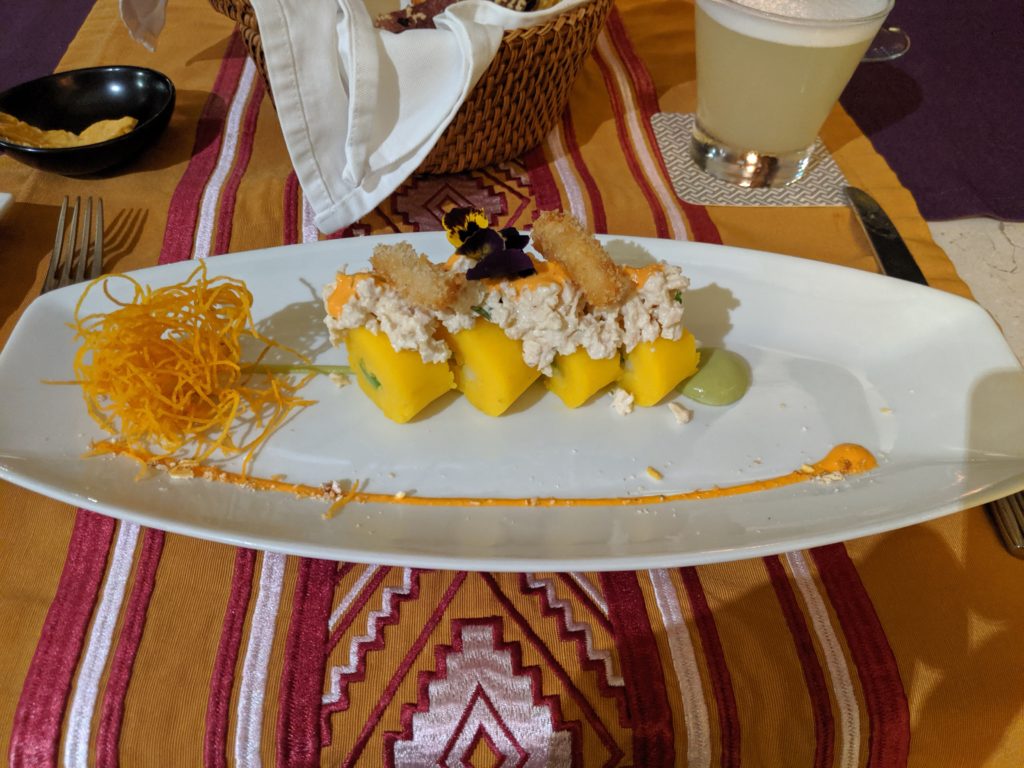
Causa
For an entree, I ordered an alpaca steak. It is served with mashed potatoes, green beans and carrots, and huancaina sauce. This sauce is made from the yellow peppers that Peru is famous for, and is a delicious accompaniment. The alpaca is nice and tender. It has the texture of very tender beef. But it’s very mildly flavored. Not like a gamey or stronger flavor, but almost like beef that was brined, soaked in water so that the stronger flavors leach out. It was a good, delicate meal. And now I have done it, and I won’t need to ever eat an alpaca again.
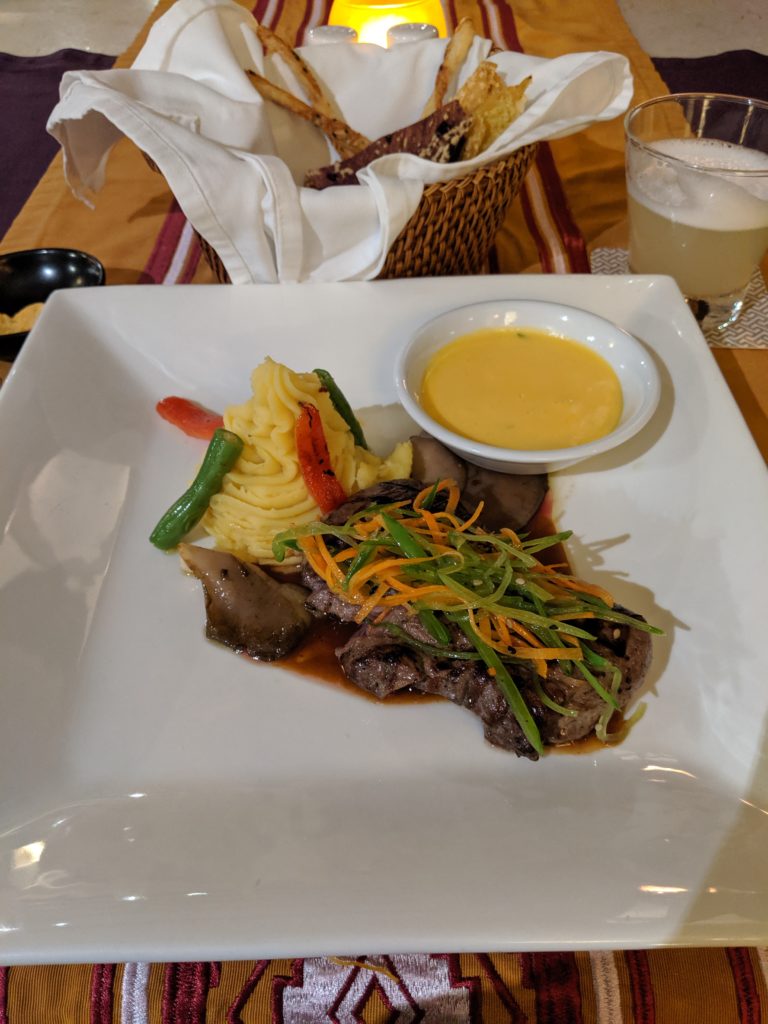
Presentation 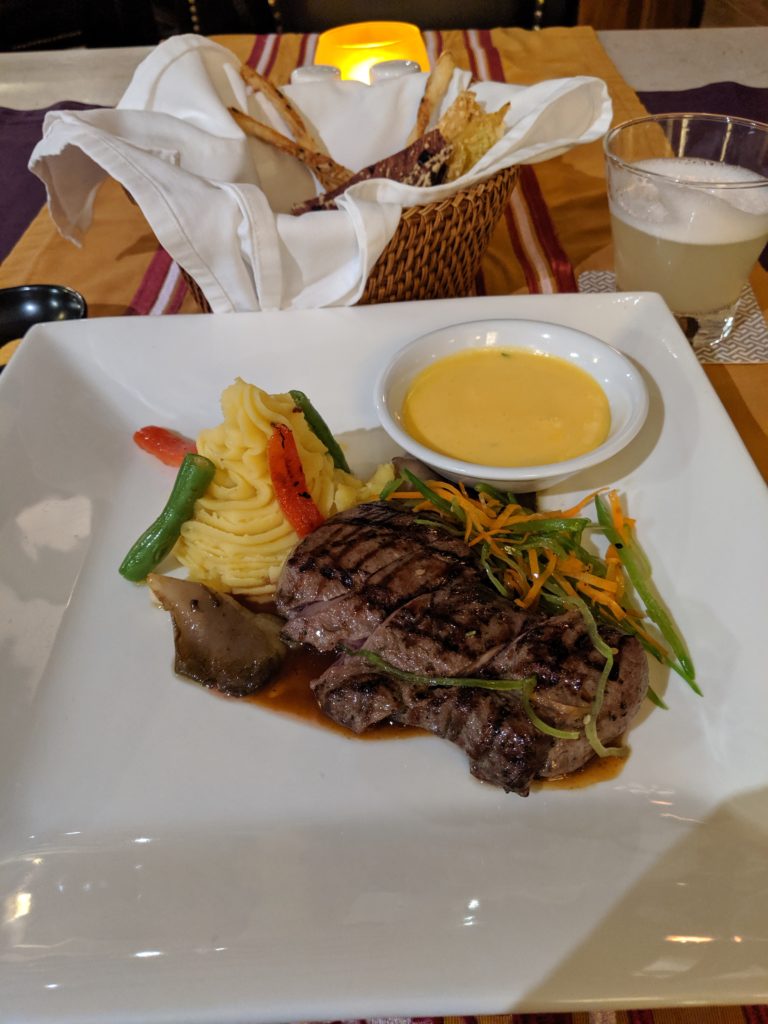
Moving the veggies aside – alpaca tenderloin
For dessert, I had the Lúcuma Lava Cake. This is a nice, tender lúcuma flavored cake with a liquid lúcuma flavored filling, served with ‘coffee paper’, a brittle coffee-flavored sheet and a dollop of coffee ice cream. The cake is delicious, though not as strongly lúcuma flavored as I’d expect. It’s just mild and generally sweet, almost just a vanilla/caramel cake. The coffee is a nice bitter accompaniment to the sweet cake. After dinner, I called it a night and went back to my room, where there are chocolates on my pillows and a little dessert plate of lúcuma custards on the table.
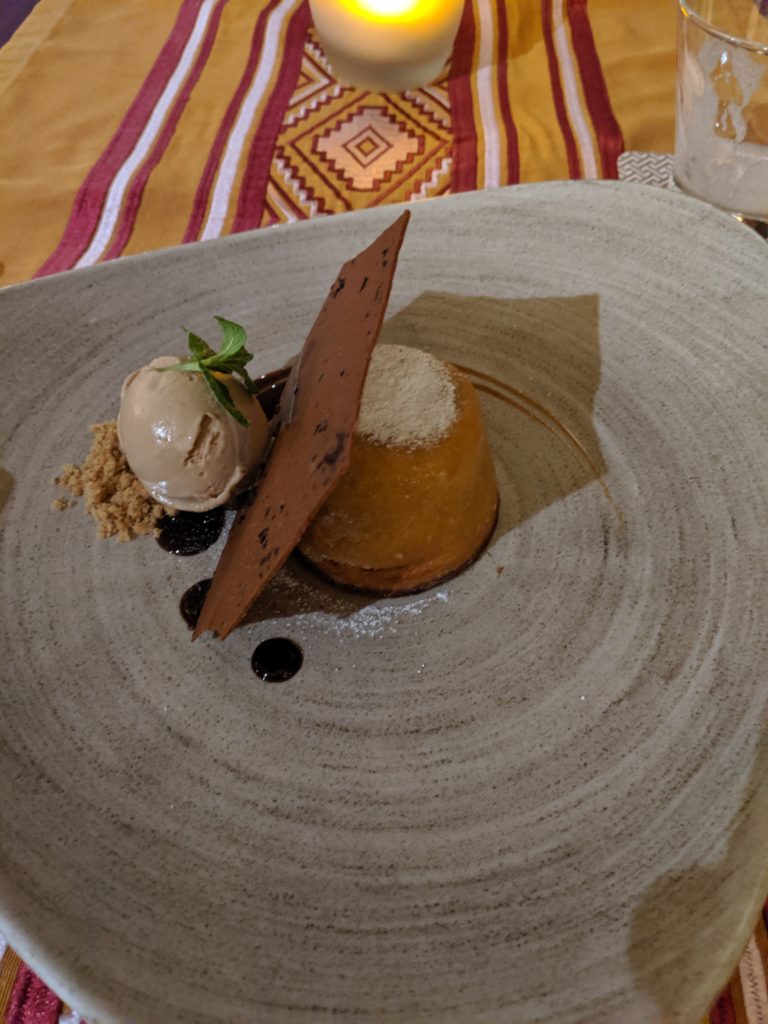
Lúcuma lava cake 
Mmmmm, lúcuma lava 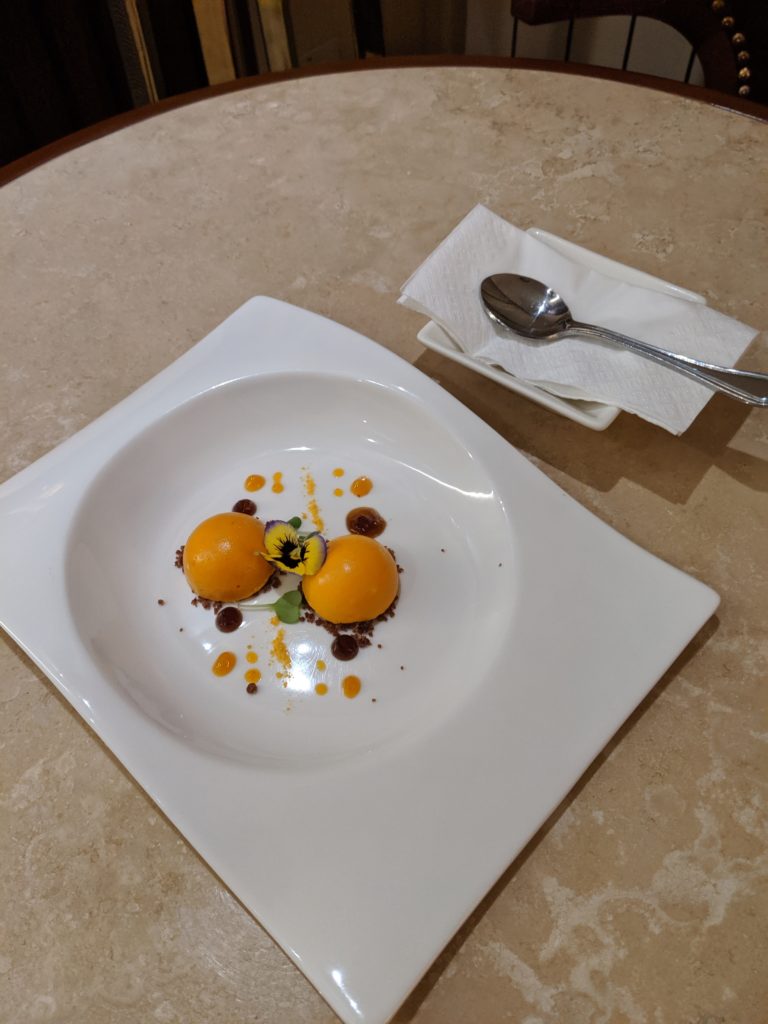
Little lúcuma custards awaiting me in my room
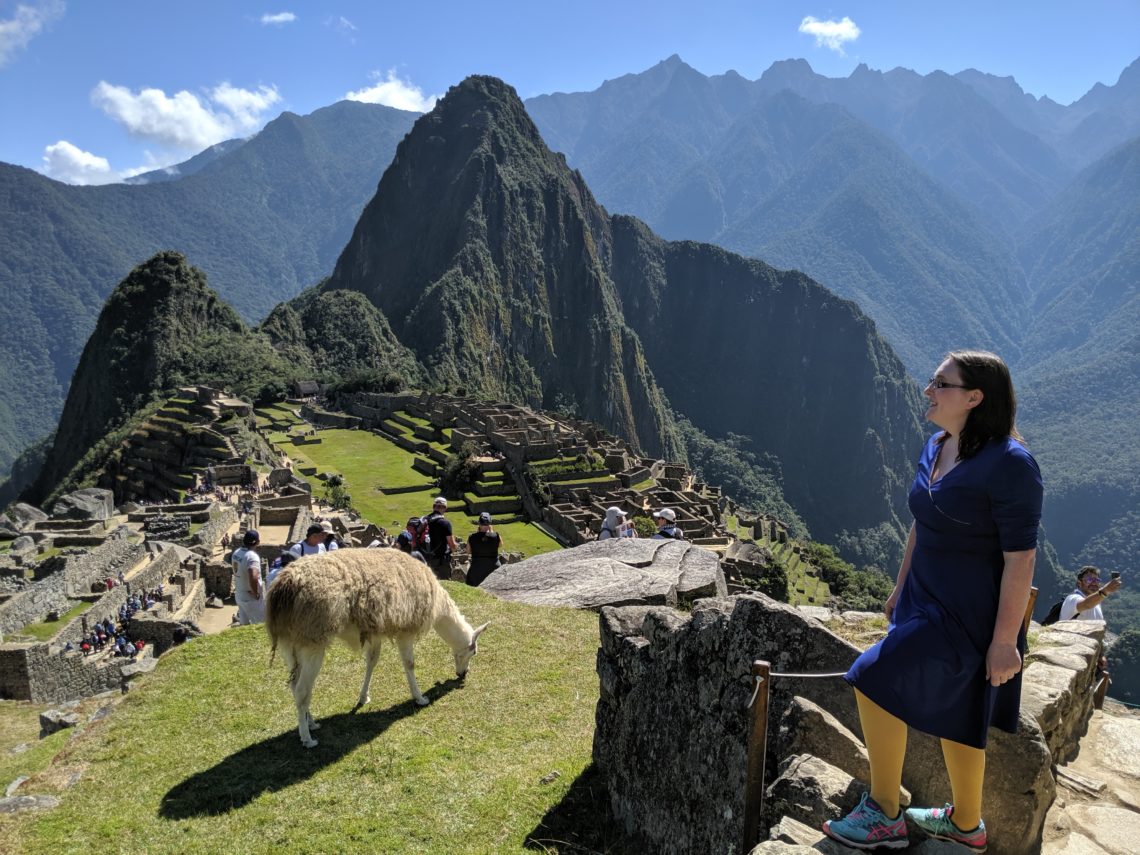


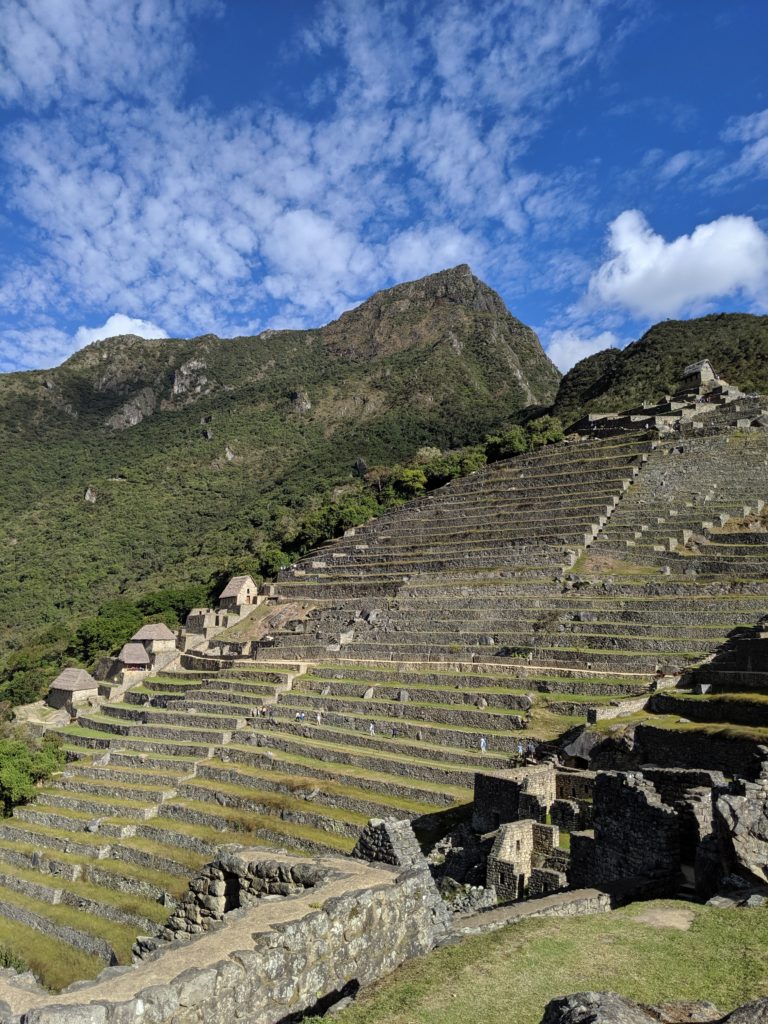

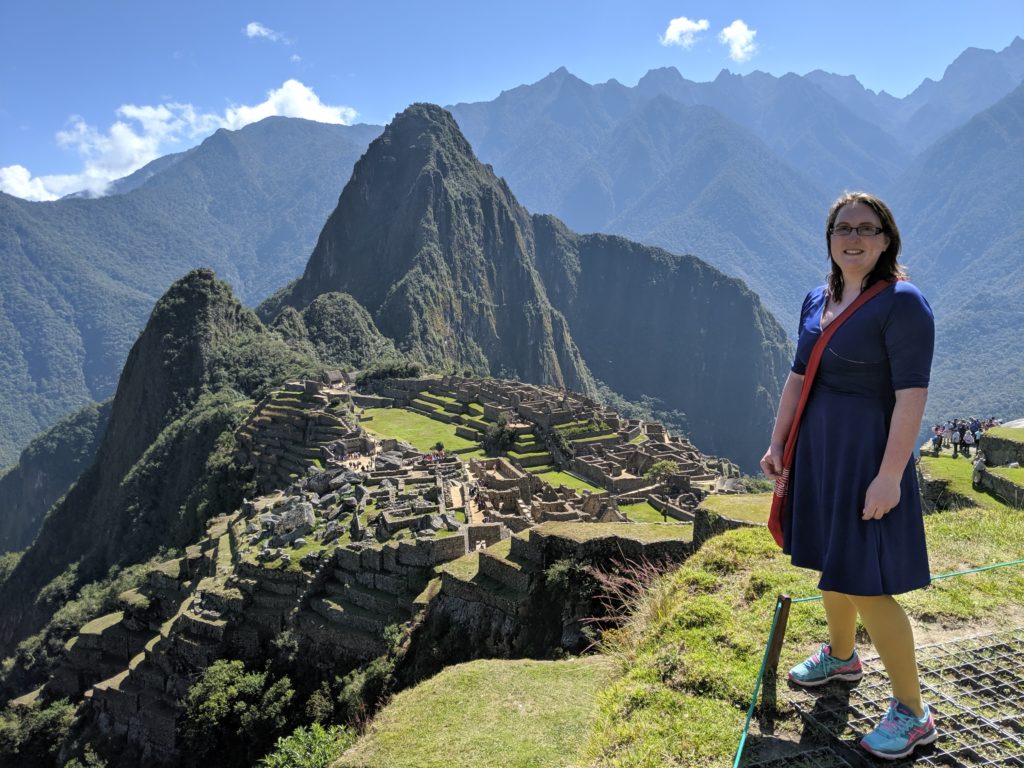



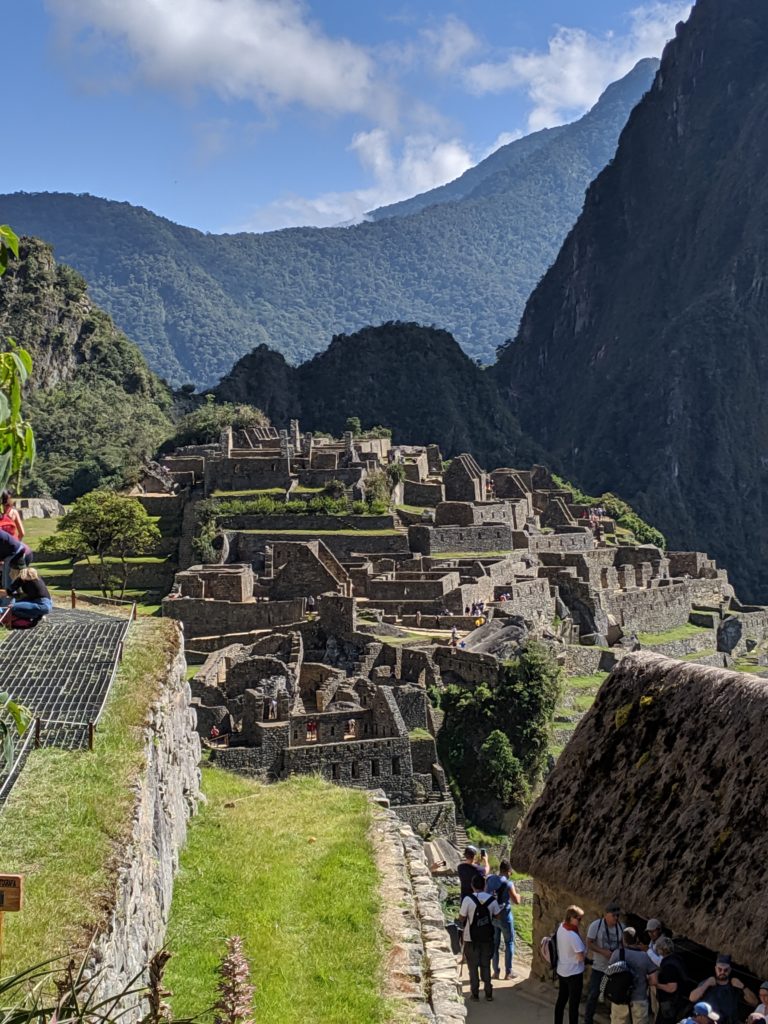
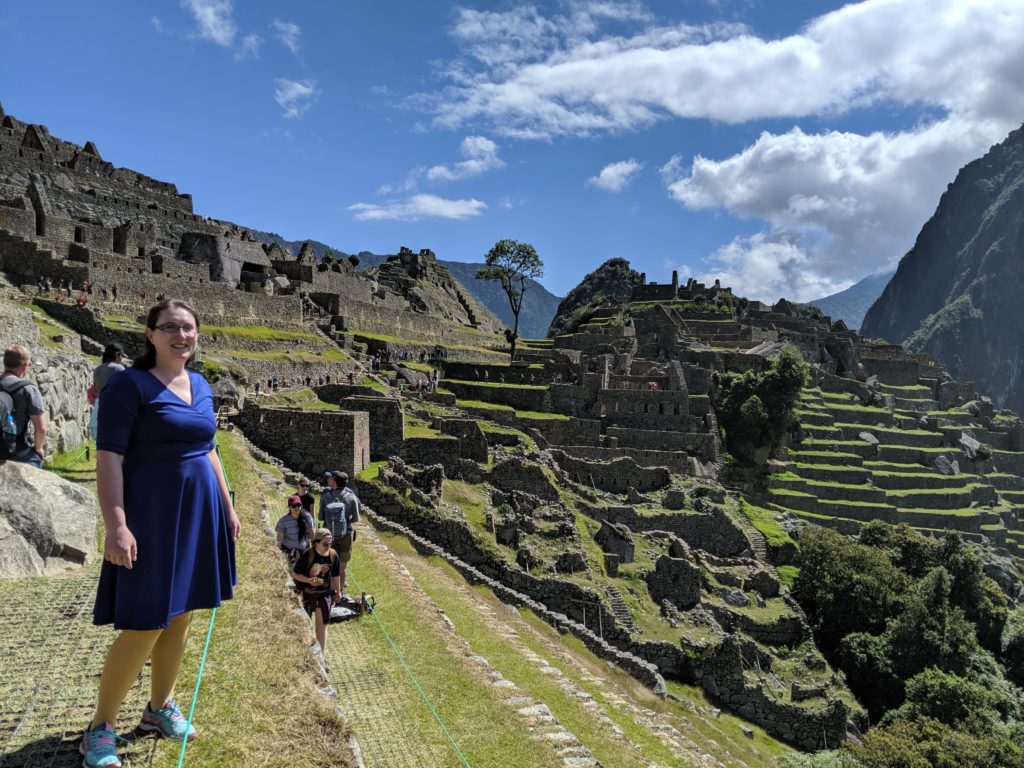
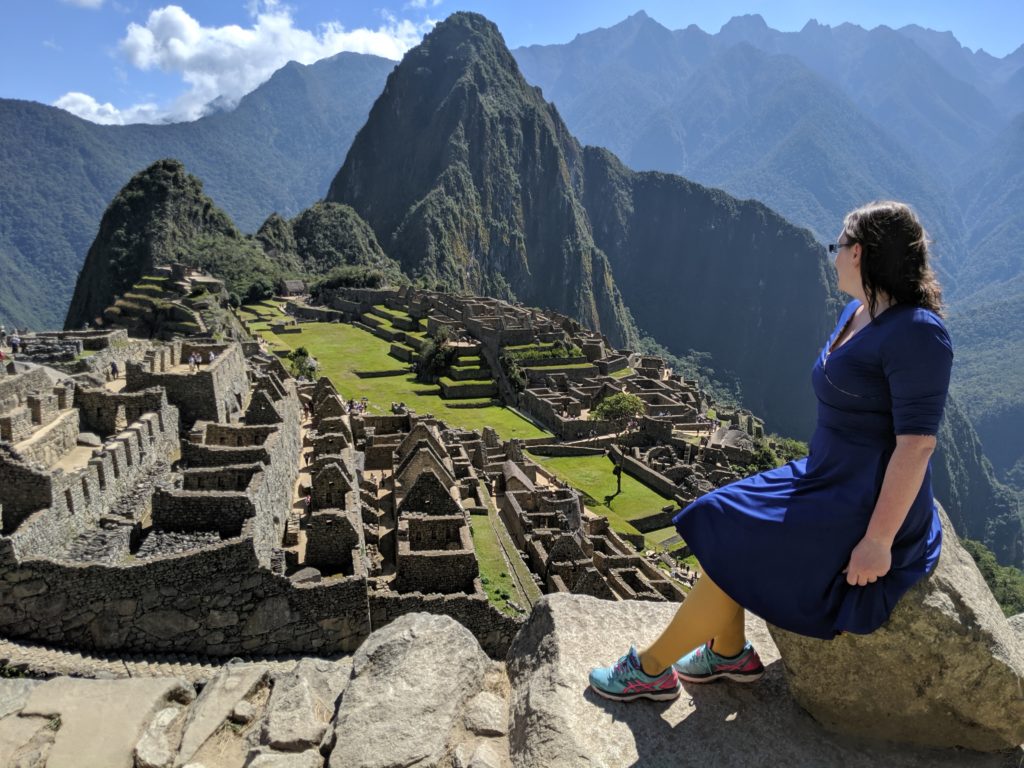
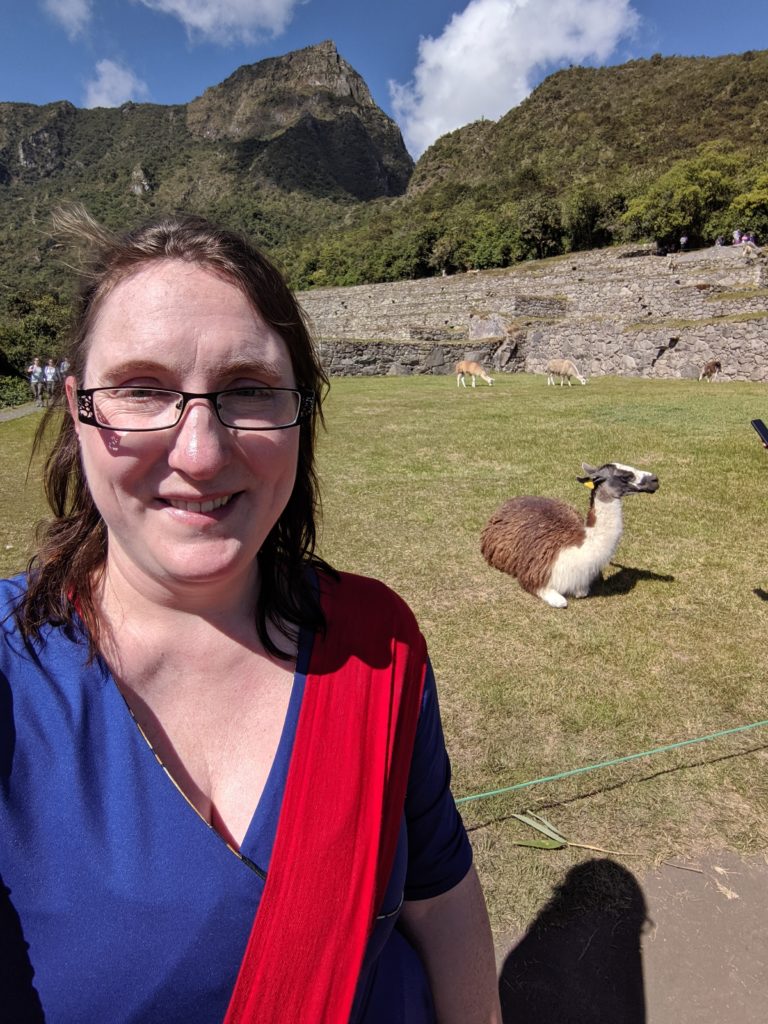

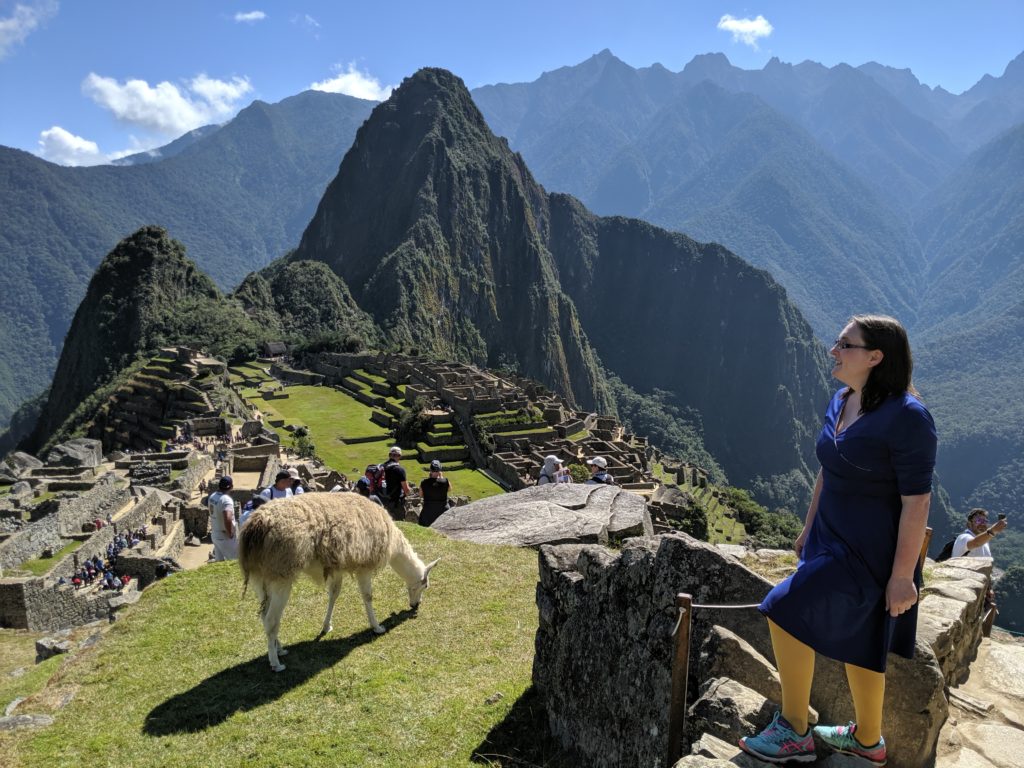
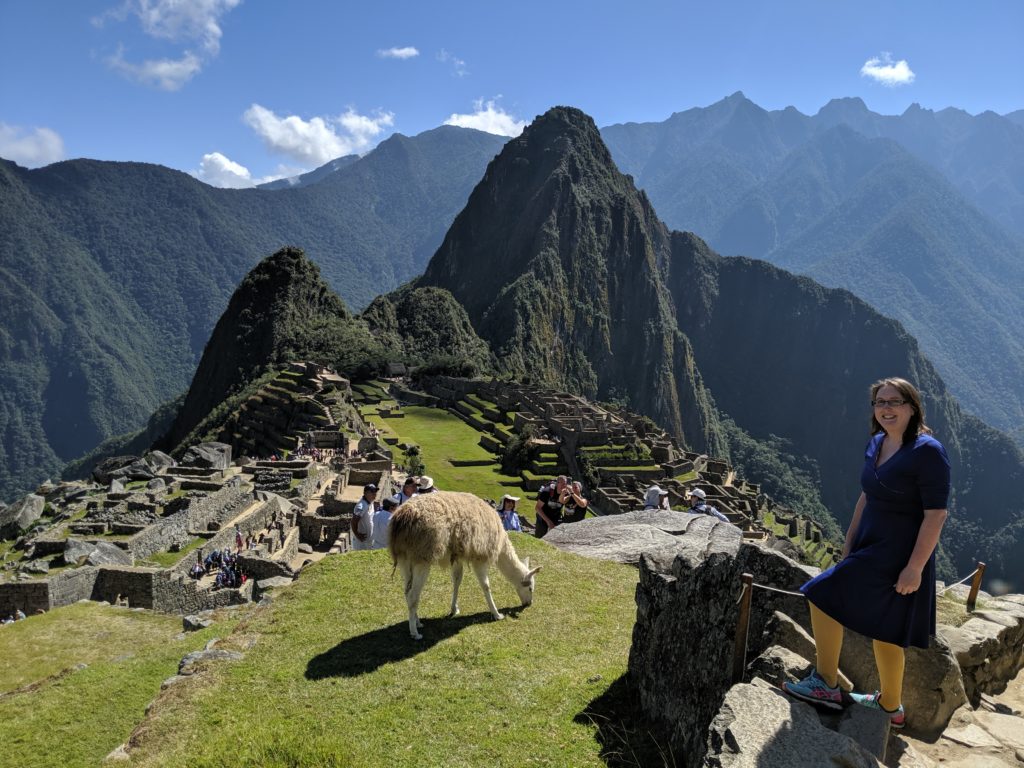

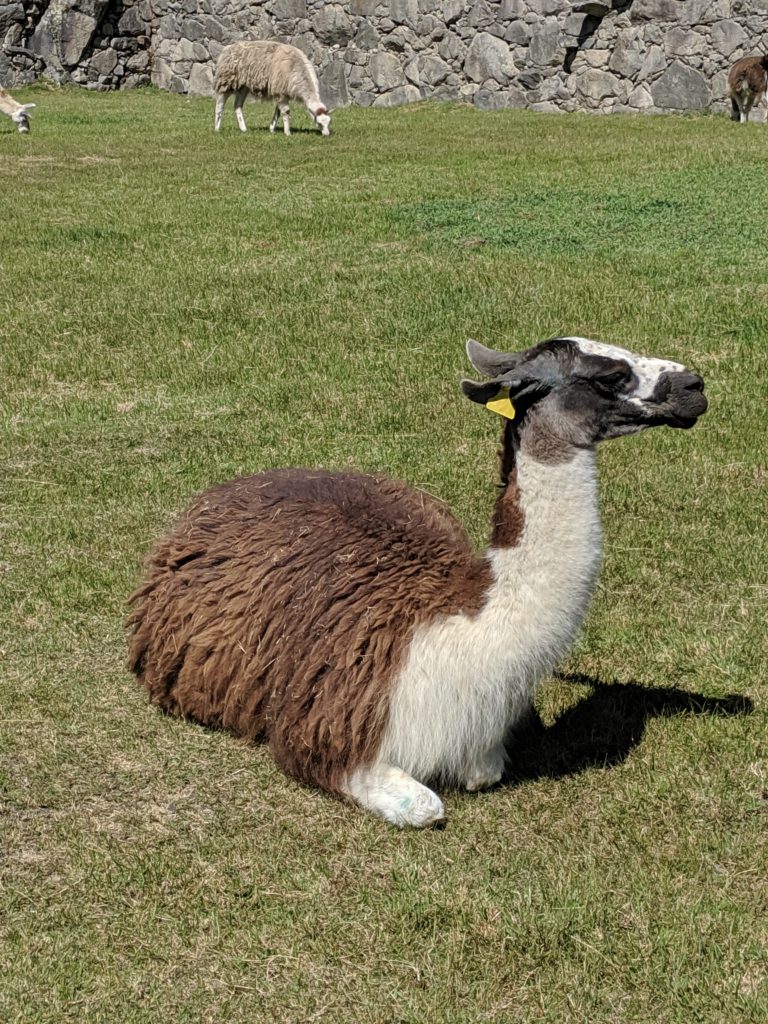
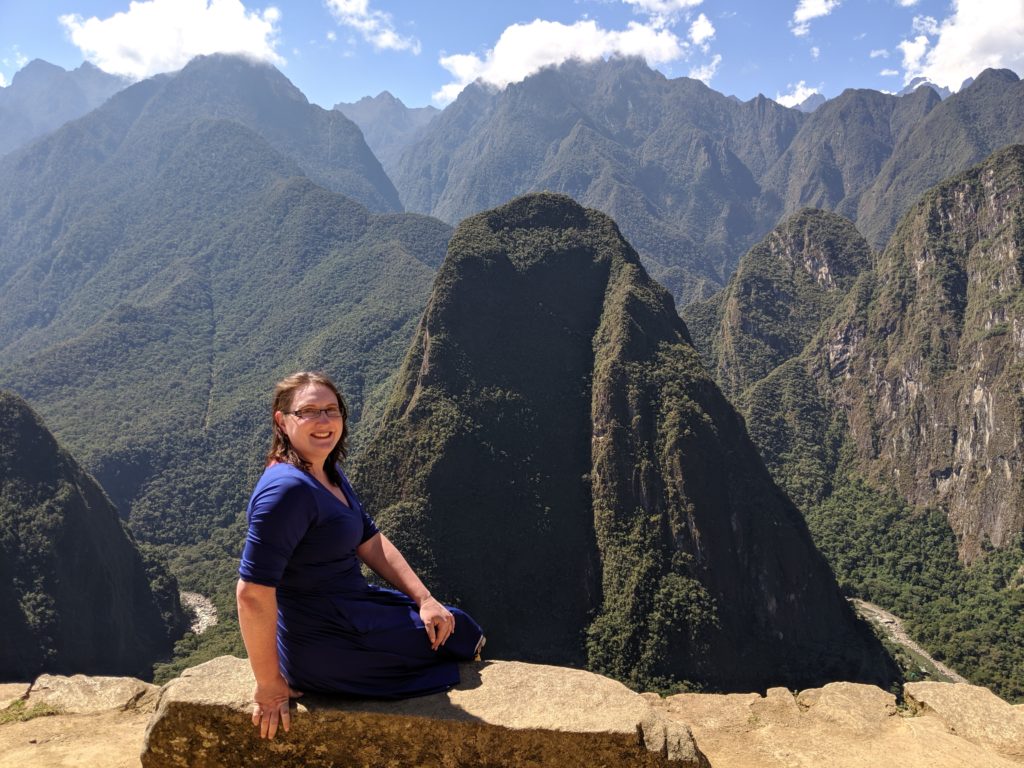



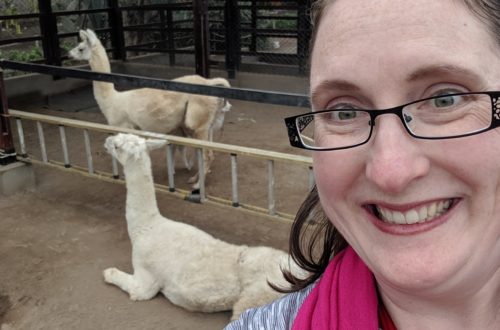
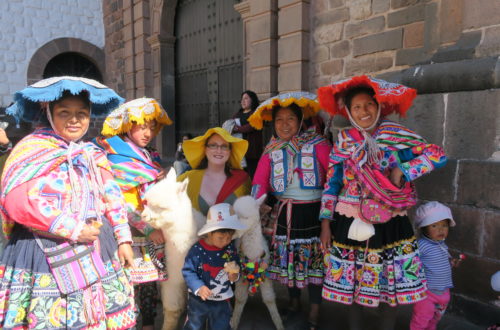

2 Comments
Clare
Thank you again, Tina! I loved reading about your adventure from today. Definitely not too many pictures. I am actually happy you did not bring your shorts because you in the blue dress just adds to the beautiful photos you took. It brings back such vivid memories when I visited Peru nearly 20 years ago…I don’t remember these tickets to wait in line though…must be a new thing? Amazing photos…do you have a camera or is that just a great smart phone? I applaud you for trying new things like alpaca meat lol…so brave! Thank you again for sharing your adventures. You make me feel as though I were there as well. xo
Tina
Thanks Clare! Haha, even the tour guide said I was ‘brave’ for trying the guinea pig. And yeah, I think that there are way more people traveling now and things are more accessible, so they’ve had to put a strict limit on how many people can go into Machu Picchu in a day, which is why the tickets and lines are so specific. I was there during the beginning of tourist season, so it was apparently at about 50% capacity (and even then, I thought it was quite crowded). I can’t imagine what it’s like mid-summer with double the people. As for the photos, I took almost all of them with my Pixel 3 phone. I have been really happy with how they turned out.